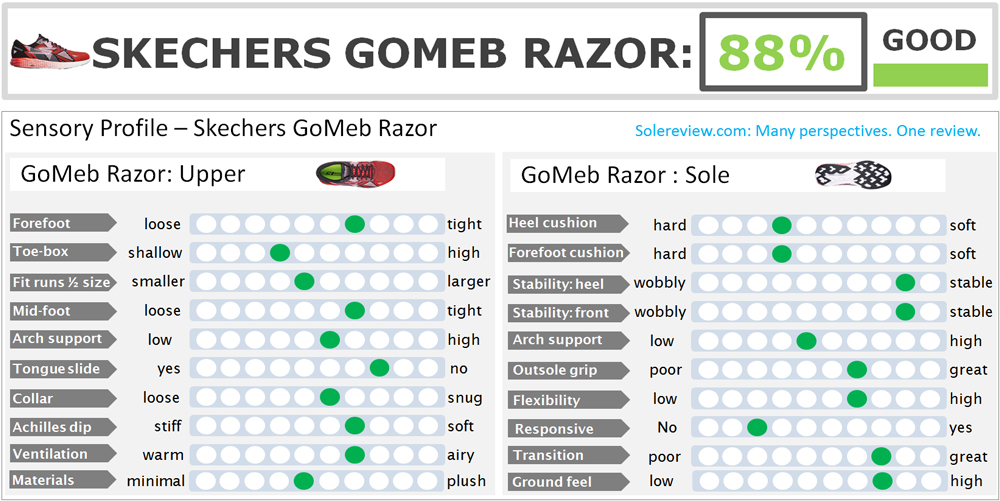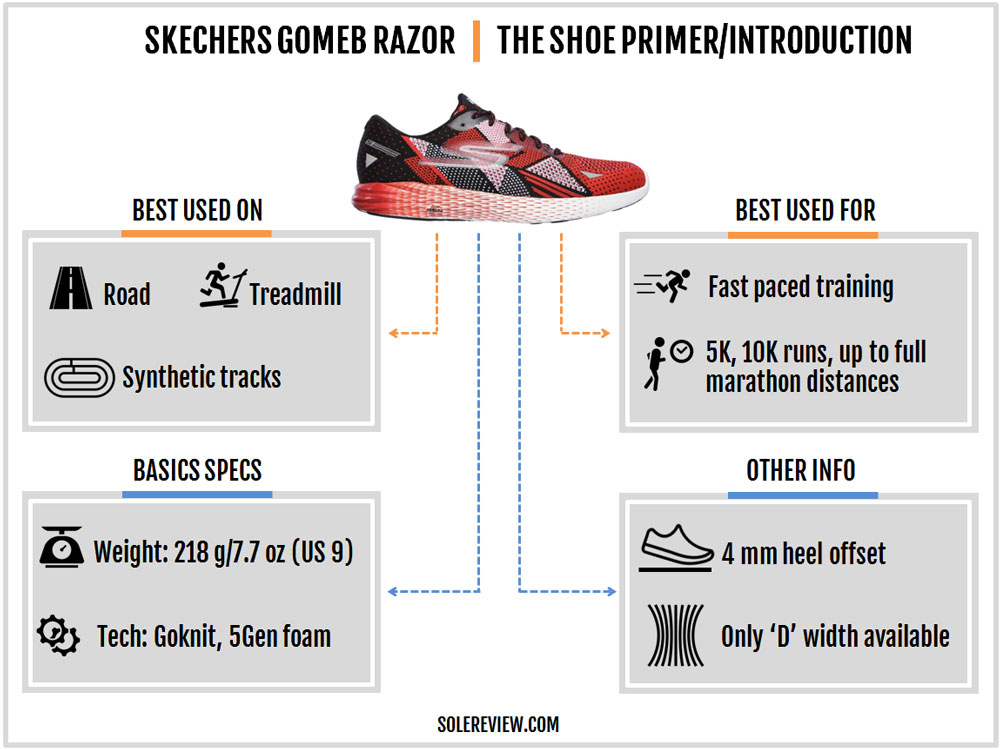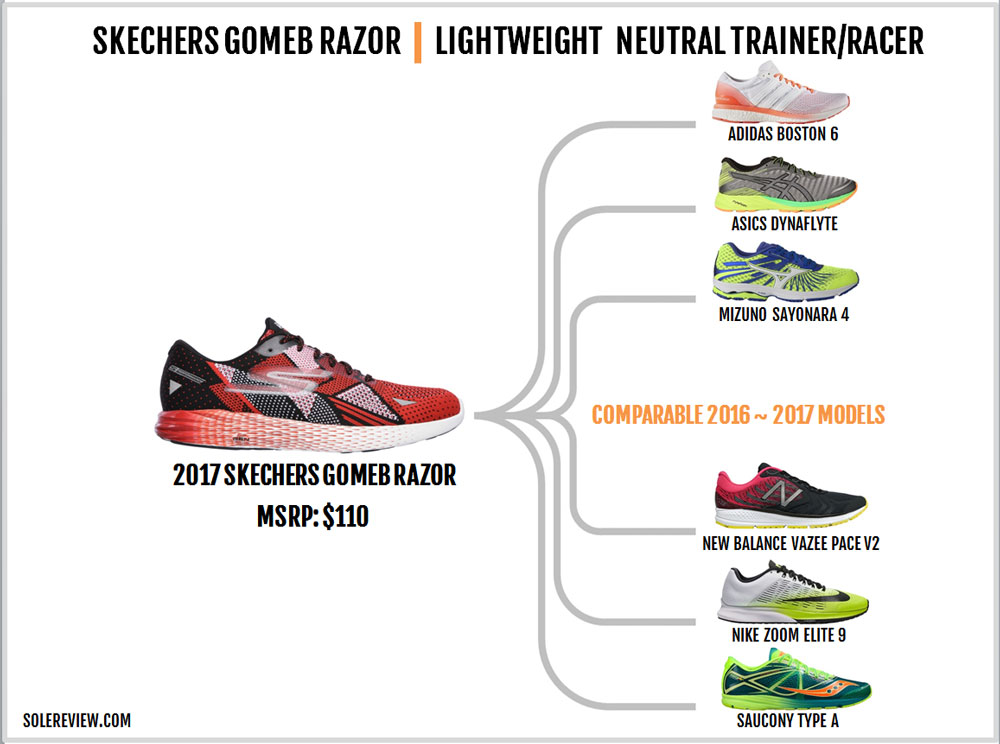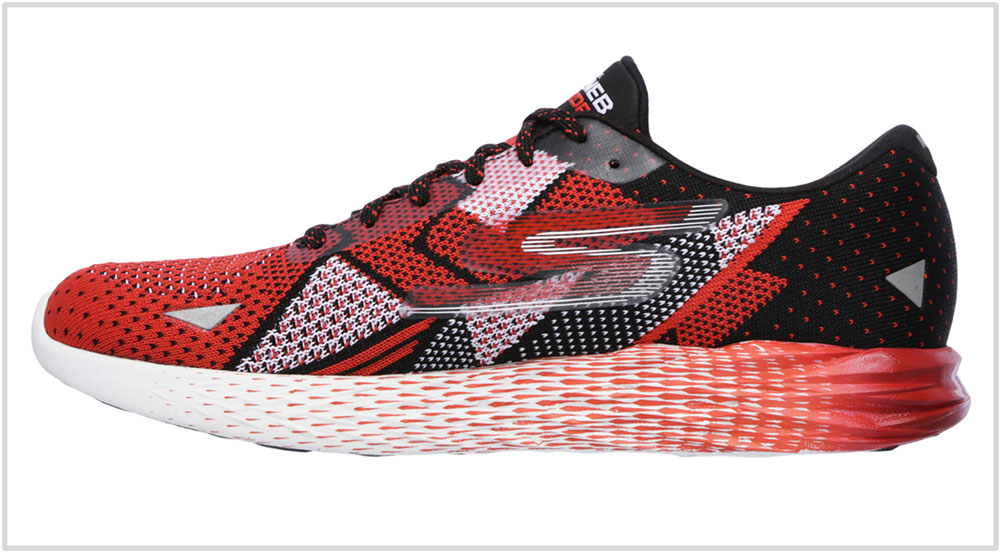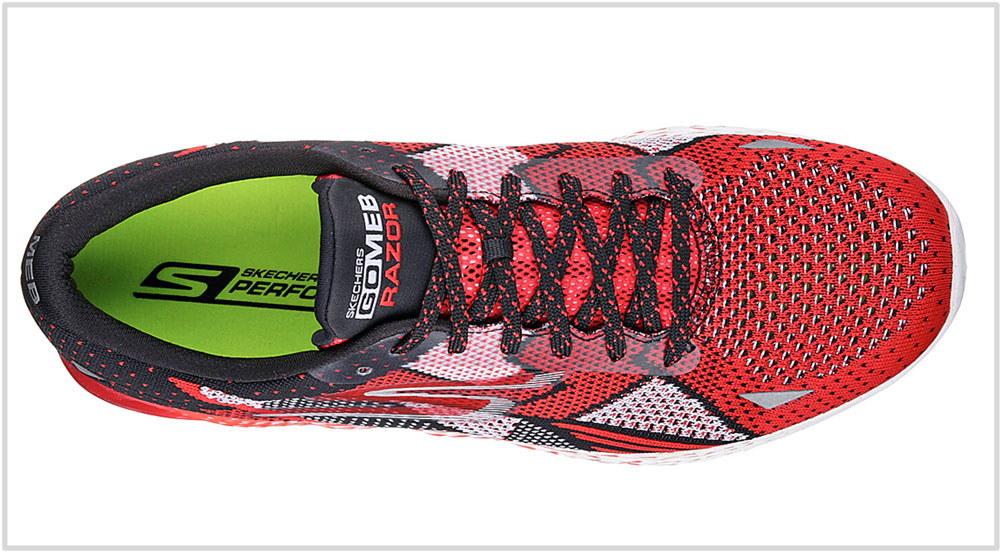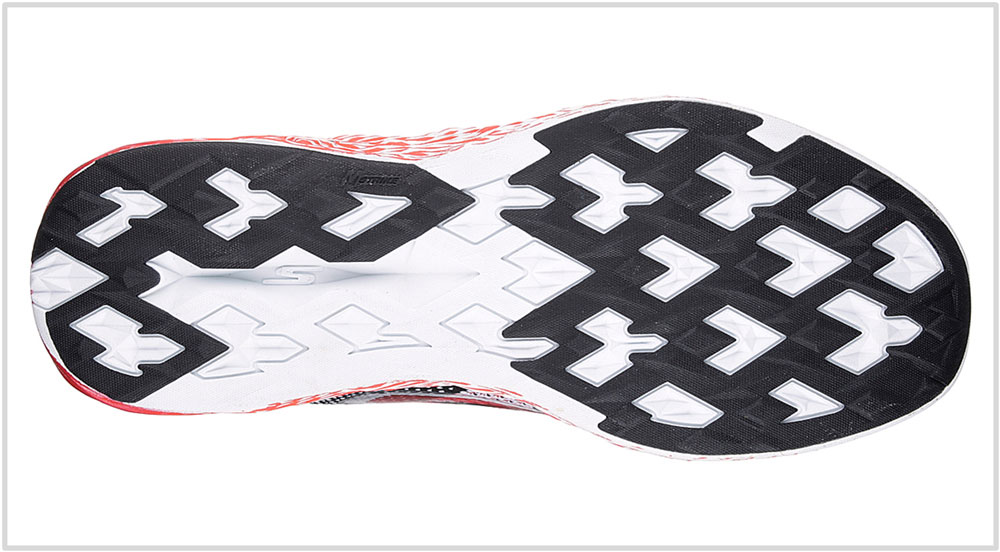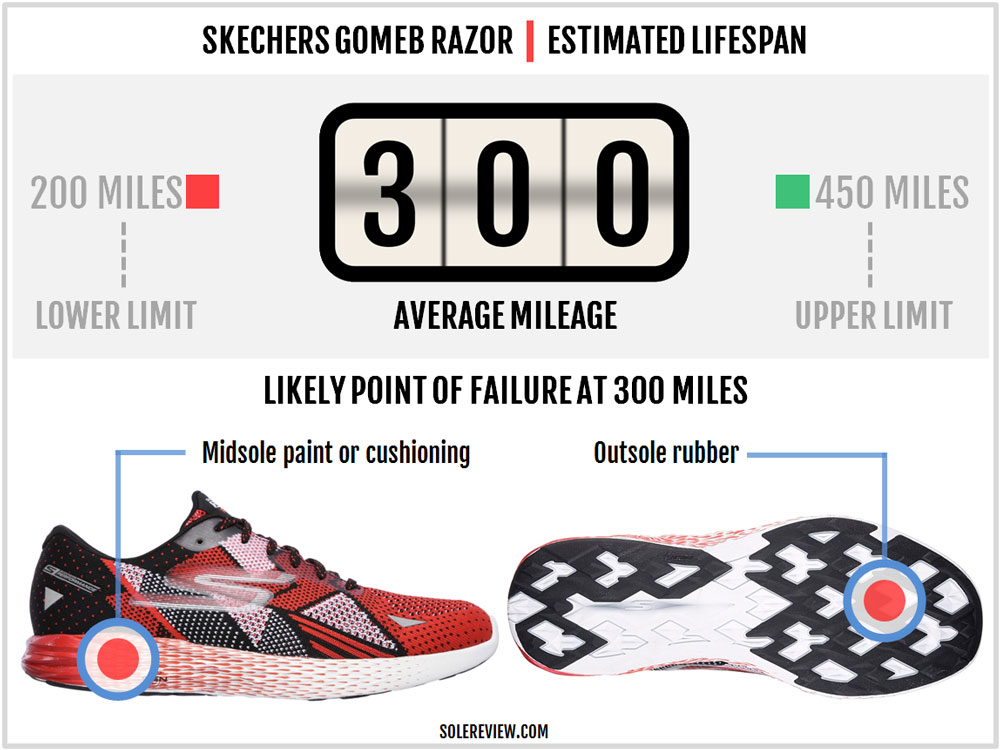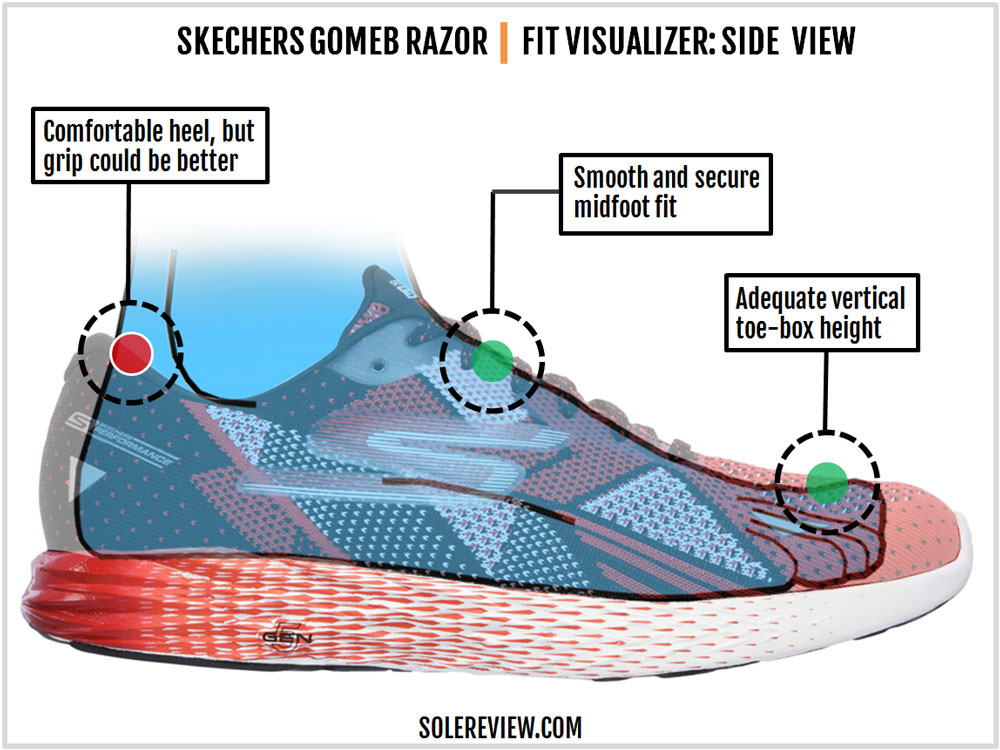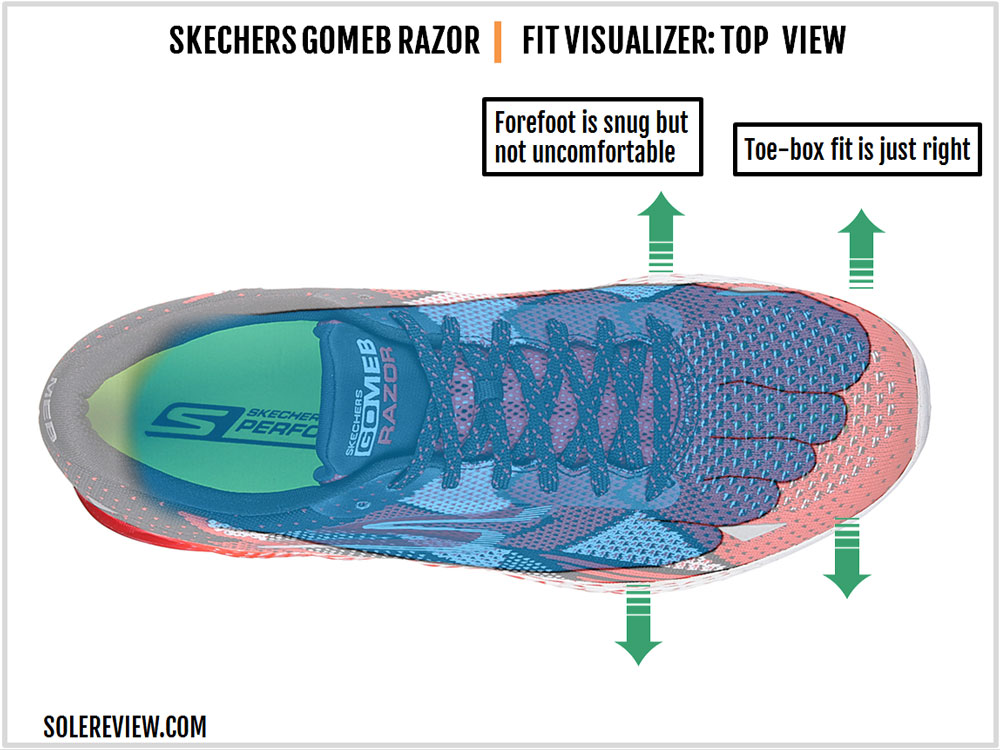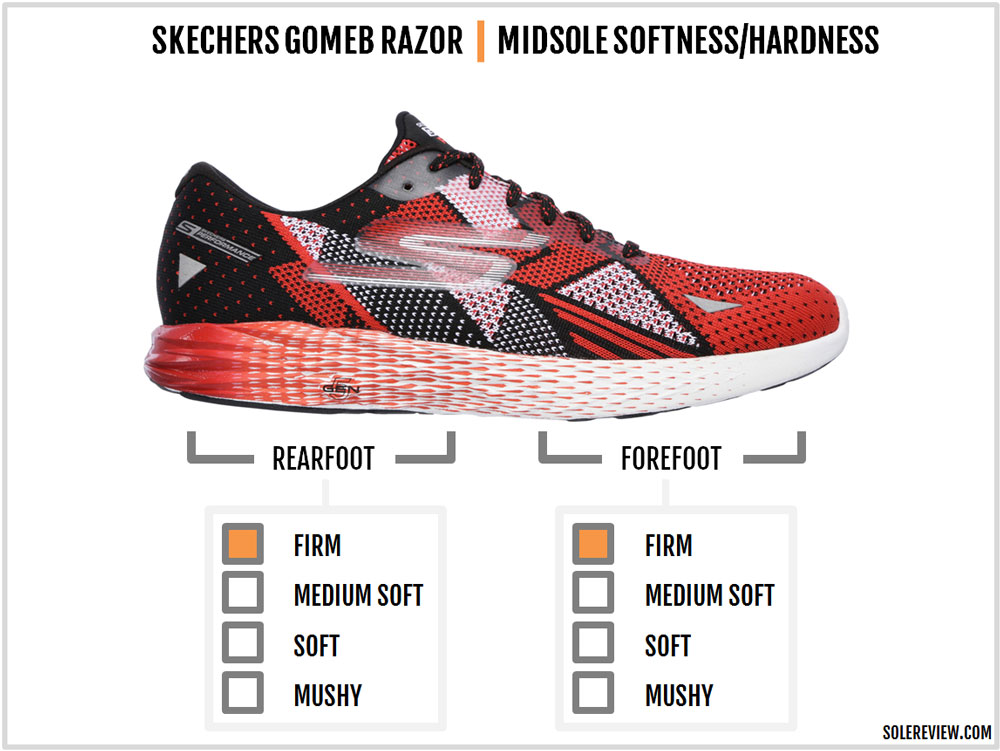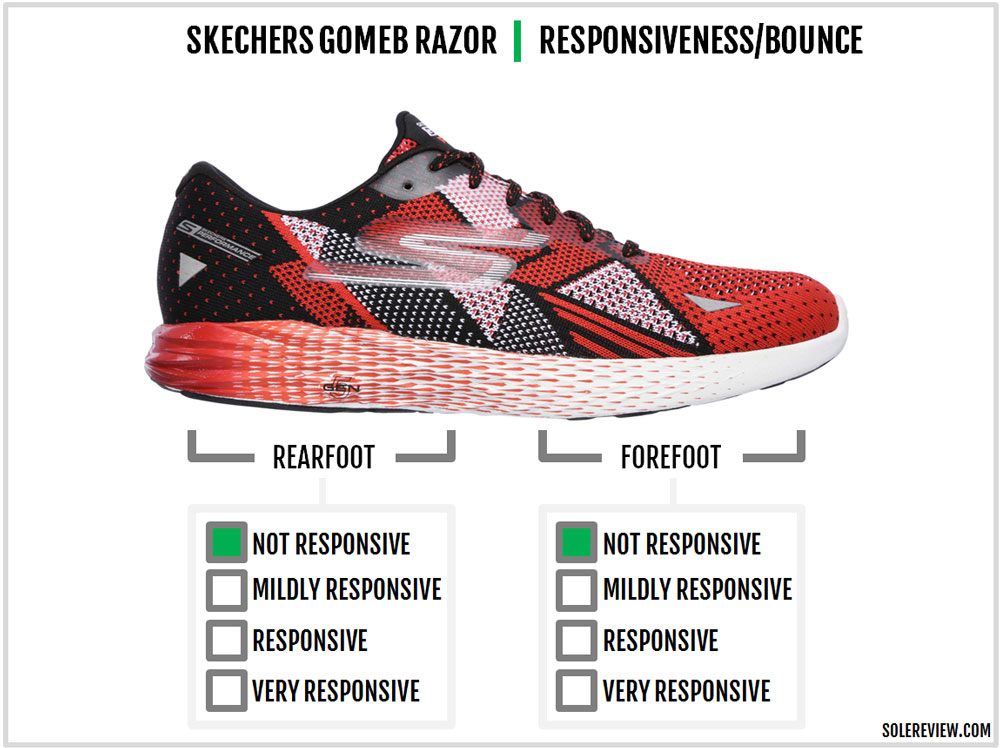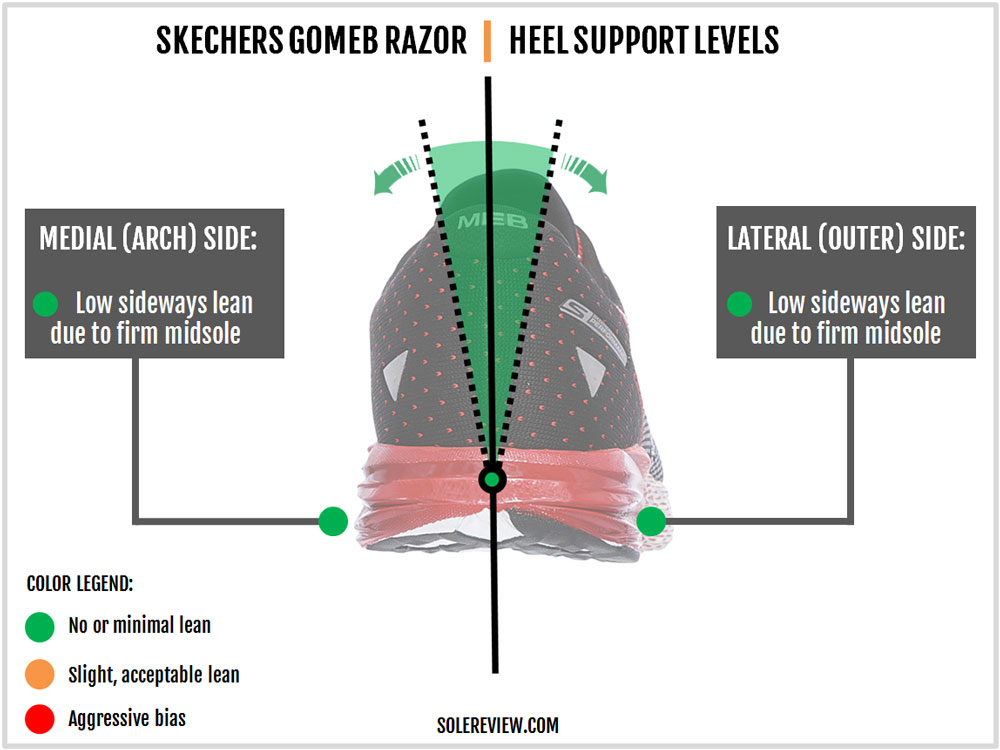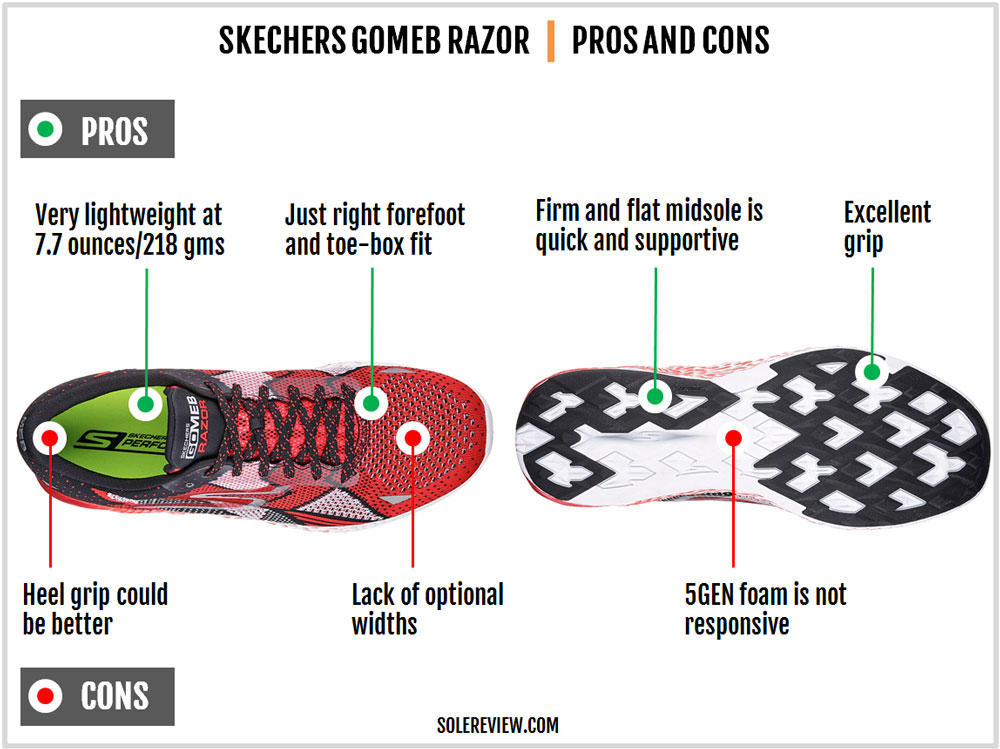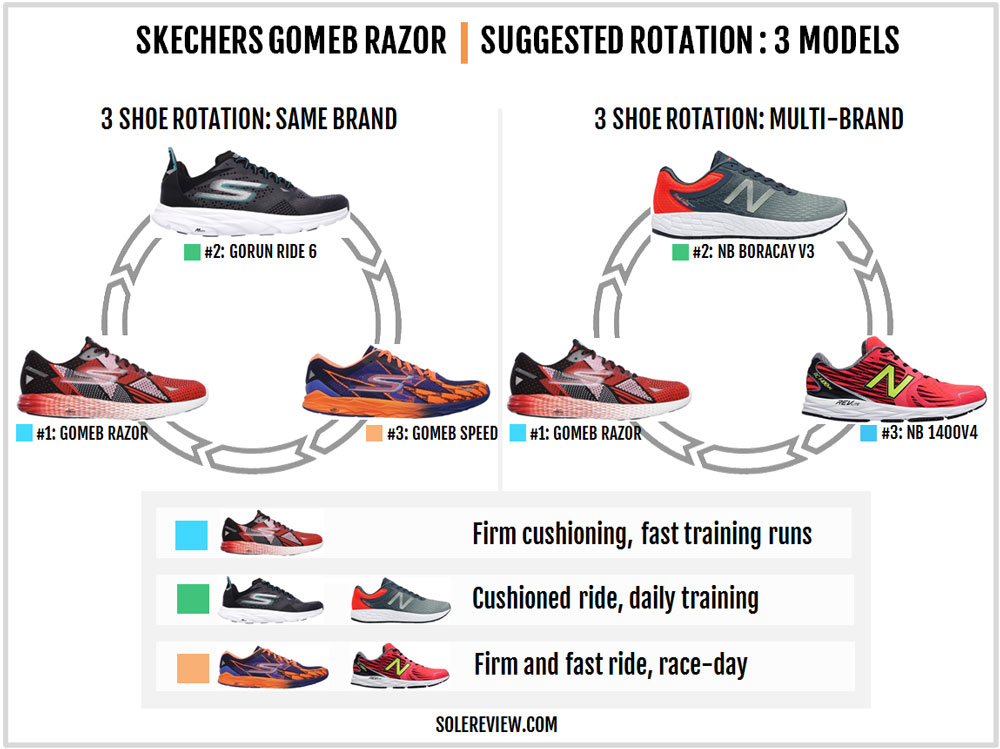INTRODUCTION
You can still count the number of Skechers’ performance (neutral) running models using the fingers of a single hand. Don’t believe us? Let’s do this.
At the soft cushioning end of the spectrum, you have the Skechers GoRun Ultra in its road and trail avatars. Next in line is the Skechers GoRun Ride 6 with its generously padded EVA midsole.
Things take a firmer turn with the Skechers GoRun 5, which is a lightweight trainer with a midsole less softer than the Ride 6. And equipped with a stiff midfoot plate and a firm ride, the GoMeb Speed 4 is Skechers’ idea of a racing flat.
The GoMeb Razor elbows its way into this mix of products, positioned between the GoRun 5 and the GoMeb Speed. It shares the same midsole and outsole as the GoRun, and has a knit upper like the rest. Skechers markets the Razor as the shoe Meb Keflezighi uses for his training runs.
So how is the midsole-sharing Razor differentiated from the GoRun?
The midsole has a slightly firmer density than the GoRun 5, and the Razor’s upper holds the foot better. The higher number of lacing rows deliver a better lock-down vs. the comparatively easygoing upper fit of the GoRun 5.
The GR5 has a fewer number of lacing rows than the Razor, and the fit is augmented by a pair of elastic straps. We must add that because of its tighter fit, the GoMeb Razor works better on tracks than the GoRun 5.
Honestly, with the introduction of the GoMeb Razor, the GoRun 5 now seems unnecessary. Because if you wanted a cushioned Skechers with a 4 mm heel drop, then the cushioned GoRun Ride 6 fills the role very well.
Both the GoRun 5 and GoMeb Razor are positioned as training shoes, so why clutter the assortment with two of a similar kind? In our view, the Razor is a better version of the GoRun 5 – and that makes the latter redundant.
The GoMeb Razor is a training shoe for fast runs; at least that’s what Skechers says. But for most of us, a shoe like the Razor serves a dual purpose; it also works equally well as a race-day shoe. It’s light, snug fitting and grippy – all hallmarks of a product which performs well during races.
These qualities slot the Razor in the same class as the adidas Boston 6, Asics Dynaflyte, Mizuno Sayonara 4 and the Nike Elite 9. These competing shoes are different in many ways but all have a dual-purpose character.
The Boston 6 is a perennial favorite with runners who crave speed as well as cushioned support; on the other hand, the Dynaflyte uses Asics’ new Flytefoam midsole platform to deliver a fast training shoe.
There’re others, such as the firm Mizuno Sayonara 4 and the very lightweight Nike Zoom Elite 9. The Mizuno has a predictable ride thanks to the ever-present Wave plate, and the Nike Elite offers a very decent amount of cushioning for very less weight.
While the Saucony Type A is technically a racer, its 4 mm offset and overall ride firmness are attributes shared with the GoMeb Razor. This is the right time to point out that there’s one aspect in which the Razor differs from all others (except the Saucony Type A). The Skechers midsole features a heel-to-toe gradient of 4 mm, which is much lower than the assortment average of 8 – 10 mm.
DESIGN AND MATERIALS
It’s been only a few years since adidas’s Primeknit and Nike Flyknit uppers hit the market, but the rest of the market has been quick to adopt the knit upper concept. From Hoka to Altra to Skechers, most are ditching the old cut-and-stitch template for the seamless, knit upper design.
Skechers knit upper is called GoKnit, a clever play on words which ties in its GoRun, GoMeb, and GoWalk product lines. As such, all knit uppers are fundamentally the same, except for a few variations in aesthetic design or the amount of stretch available.
The Razor’s knit upper has no stretch and like others, has a single-piece construction without seams inside. The toe area is reinforced with an internal stiffener, and the heel has a hard counter. Both these components are invisible from the outside but provide the upper with shape and fit.
There are no external layers except for the lacing area which is laminated, the fused Skechers logo on the sides, and the reflective bits over the forefoot and rear. The tongue is minimally padded, and attached to the knit upper without a sleeve. The laces which pass over it are a thin, flat kind with no stretch.
Regardless of its sleeve-free design, one doesn’t experience a lot of tongue slide. Like Mizuno, Skechers uses a wide flap which prevents the tongue from sliding a lot.
The ‘Meb’ callout on the Achilles tab indicates the Razor’s signature series pedigree. Unlike the GoRun 5, the heel has a simple shape and is devoid of the pull tab which Skechers calls ‘Quick-Fit.’
This peculiar looking Quick-fit made its debut a couple of years ago and is present on the GoRun 5 and GoRun Ride 6. The GoMeb Speed 4 does not have this, and instead shares a similar heel design with the Razor. The Razor’s heel is padded with decent amounts of foam, and has the same lining mesh as the GoRun.
Many of the newer Skechers performance shoes have ditched the pillar-based sole design for a flatter profile. Also, Skechers appears to be moving away from the rocker-shaped midsole design.
The GoRun 5, Razor and the Speed now showcase a midsole template which is free of the ‘M-Strike’ curve; only the GoRun Ride 6 retains both the pillar midsole and the M-Strike rocker. The Razor does have the ‘M-strike’ wording on its outsole, but the heel and toe no longer have the prominent upwards curve.
We get to see and experience the new midsole and outsole design language on the Razor. Replacing the curvy midsole profile is a flat surface with increased ground contact. There’s a lot more rubber too.
Except for the inner midfoot, the rest of the outsole is covered with a thin sheet of rubber. The geometry has lugs made of slightly raised rubber and exposed midsole foam; both are meshed together to provide traction.
Compared to the earlier pillar-shaped outsoles, the flatter design provides a higher level of grip. The thin rubber sheet has excellent traction, and that’s further helped by the increased surface contact.
The midsole material is compression molded EVA foam molded with sharp, angular cuts on its sidewalls. There’s a lot of midsole paint over it, a design treatment which adds visual depth.
It is important to note that this cosmetic detailing distinguishes the GoMeb Razor from the GoRun 5. The latter has the same midsole but without the Razor paint job.
Skechers calls its midsole material ‘5Gen’. The midsole foam and design are the same for the GoRun 5 too, except that the Razor’s midsole is slightly firmer in density.
If there’s one thing we can say with certainty, it’s that the new outsole geometry has increased durability over the older pillar design. The protruding foam pillars had the tendency to show accelerated wear in footstrike and transition areas.
In comparison, the flat outsole layout takes daily abuse in a more spread-out manner, therefore prolonging the outsole life. The newer Skechers outsole also has increased rubber which further help in the matters of lifespan.
That said, the rubber used is soft and thin, so don’t expect 500 miles out of the Skechers GoMeb Razor. 300 miles is the estimated median lifespan, and anything beyond is a bonus. Standard aging of midsole foam will apply too; after all, the 5GEN foam is nothing more than relabeled EVA.
The midsole cosmetics will also be a casualty. The paint is likely to flake off over time, although that will have no effect on the Razor’s functional performance.
You should be good with the knit upper. There are no stitched components or joints to fail, and the mesh itself is quite thick.
UPPER FIT AND FEEL
The interior is smooth because of the no-sew knit construction, and there are no pressure hot spots or seams. The internal stiffener creates adequate vertical toe-box room.
The heel is somewhat pliable, as the counter used inside is a thin kind. The collar grips well, but one wishes there was slightly more grip. But at least the heel isn’t uncomfortable like the design used on the last year’s GoMeb Speed 3.
Overall, the Razor has a well-proportioned upper fit. It secures the foot during fast runs, and at the same time, you don’t sense a paucity of interior space. The lightweight and seamless construction of the upper has it disappearing over the foot, which is exactly what any good upper should do.
The Razor is designated as a fast training shoe, but it has none of the super-snug upper feel which usually comes with such a package. The upper provides a secure lock-down during runs, but at the same time you get things like a wide toe-box.
On the forefoot sides, the upper fit is just right, being neither too tight nor too loose. However, if our experience with knit uppers is anything to go by, expect the Razor upper to widen marginally over time. The knit mesh lacks elasticity, so any additional cinching has to come through the use of the laces.
Length-wise, the GoMeb Razor fits true to size. Unless you decide to run without the removable insole; in which case buying a half size smaller is warranted. However, we do not recommend this approach as you’ll stand to lose 4 mm of midsole cushioning.
RIDE QUALITY AND BEHAVIOR
A few components on the Razor provide softness of a mild quality. The removable insole has inbuilt cushioning which is felt immediately underfoot; the thin rubber outsole is also pliable and is integrated together with the midsole extremely well. So there’s a touch of softness in otherwise what is a firm-riding shoe.
The midsole foam has a firm quality, and the flat outsole profile adds to the overall firmness. Unlike past Skechers, the Razor’s outsole lacks the pillar pods which had inherent cushioning.
The lack of softness doesn’t mean a lack of cushioning. There’s enough material separating the foot from the road, and that makes the GoMeb Razor suitable for long-distance training and races.
Considering the firm nature of the midsole, the Razor shines at running paces of 4.45 min per km or faster. Conversely, easy running in the Razor isn’t punishing. There’s adequate cushioning, and the shoe doesn’t feel super-hard.
The 5GEN material is just EVA foam, so there isn’t a great deal of rebound. In fact, any spring-back you experience comes from the molded insole. Remove that, and the ride feels super flat.
There’s also the (new) flat outsole design contributing to the lack of responsiveness. The pillar design seen on previous Skechers models delivered rebound through compression. With those gone, the midsole loses the spring-like feedback.
The Razor is more about enhanced ground feel rather than foam bounce. You sense a better connection with the ground, so the GoMeb Razor is suited for runners who seek proprioceptive feedback.
The Razor’s midsole has a stable ride. The foam used is firm, and the sidewalls have a balanced design with no outer bias. One also has to consider the redesigned outsole which does not use foam pillars and instead uses a flatter profile. This delivers a better plant over the running surface compared to the legacy Skechers design.
The firm, single-density midsole makes transitions smooth and progressive. There’s no foam sink to cause slowness, and there’s material consistency throughout the length of the shoe. The GoMeb Razor does live up to its billing as a fast training shoe – because that’s exactly how it behaves. The shoe is very lightweight at under 8-ounces, so that’s a positive too.
The GoMeb Razor is one of those shoes where there isn’t a lot of difference between the static and dynamic heel drop. The firmness of the midsole prevents excessive compression of the heel or forefoot, so the Razor will live up to your expectation of a 4 mm offset running shoe.
If you’ve been running in higher heel differential shoes (say 8- 12 mm), the Razor’s low gradient might potentially cause temporary soreness in the early days of ownership.
PROS AND CONS
If we had to underscore only a single area of excellence, that would how the Skechers GoMeb Razor deftly juggles the roles of both a fast trainer and racer. There’s enough lightweight midsole padding to make the ride comfortable for a wide range of runs, but at the same time, the firmness and flat outsole profile allows swift transitions.
Among other niceties, the upper fit strikes the right balance between a secure foothold and interior space. During runs, the upper disappears over the foot which only makes the Razor’s case as a fast-training shoe stronger.
The liberal application of soft rubber results in excellent grip over running surfaces, and the full-contact profile produces a supportive ride.
Even with the Razor being the versatile package it is, there’re a few areas of potential improvement. The 5GEN foam compound isn’t very responsive and feels like ordinary EVA foam. Then there’s the lack of optional widths.
RECOMMENDED ROTATION
Skechers indirectly markets the GoMeb Razor as an in-between shoe, with the Skechers GoRun 5 on the cushioned side and the GoMeb Speed 4 on the firmer, faster end. So ideally, this should be the three-shoe Skechers rotation.
Solereview begs to differ.
In our opinion, the GoRun and Razor are too close a match. Instead, the more cushioned GoRun Ride 6 or the Ultra (road) is a better-cushioned companion within Skechers’ assortment. The GoMeb Speed 4 adds value as a race shoe by being firmer, lighter and snappier than both the Razor and Ride 6.
The New Balance Boracay (V3) is back after a brief hiatus. It is a cushioned daily trainer with a low heel to toe differential of 4 mm, which is the same as the GoMeb Razor and Ride 6.
Pair the Boracay with either the Brooks Hyperion or the New Balance 1400 V4; both work very well as race-day shoes.

